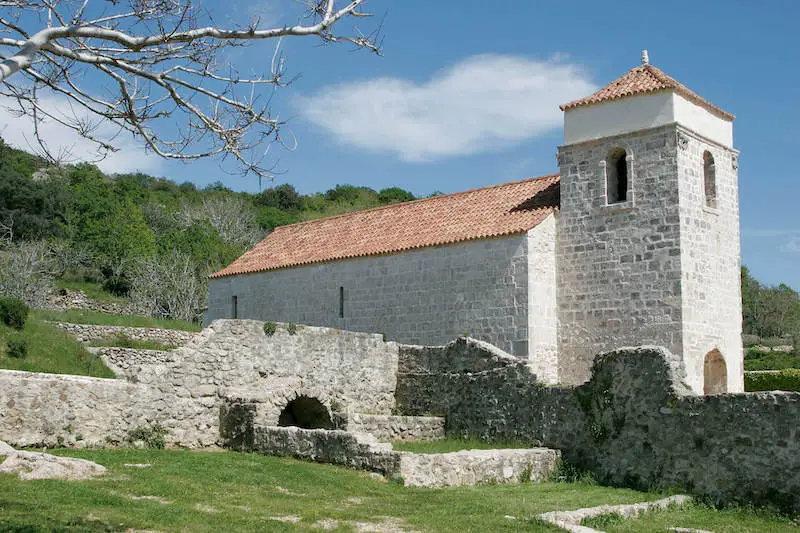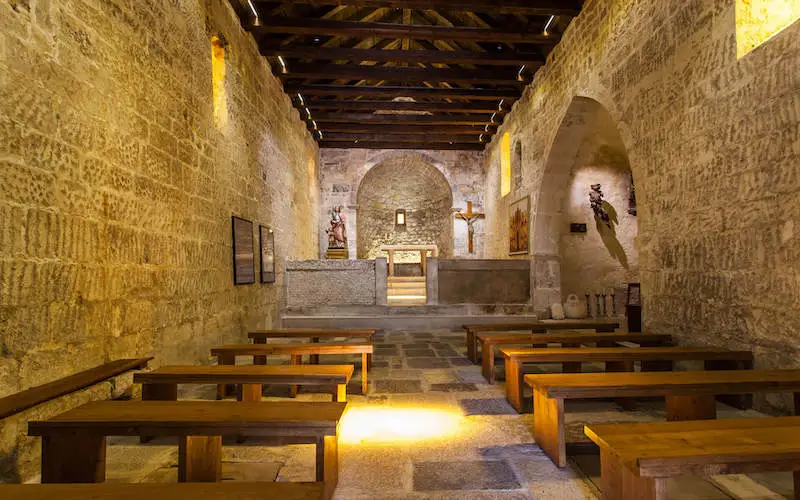The Baška Tablet: A Cornerstone of Croatian Literacy, Language, and Identity
Table of Contents
Few medieval artifacts carry as much cultural, linguistic, and historical weight for a modern nation as the Baška Tablet (Croatian: Bašćanska ploča). Carved around the turn of the 12th century and discovered in a modest Romanesque church on the island of Krk, this imposing limestone slab has become a touchstone for understanding Croatia’s medieval past, the development of its written language, and the enduring prestige of the Glagolitic script along the Adriatic. Today the original is preserved in the Croatian Academy of Sciences and Arts (HAZU) in Zagreb, while a faithful replica stands in situ at the Church of St. Lucy in Jurandvor near Baška, allowing visitors to experience the context of its creation.
What the Baška Tablet Is
Physically, the Baška Tablet is monumental. Hewn from white limestone, it measures roughly 199 cm in length and 99.5 cm in height, with a thickness that varies between about 7.5 and 9 cm. Its mass is commonly cited at approximately 800 kilograms—part of why it survived centuries of building alterations and even reuse. The text is arranged in 13 lines of carefully incised letters. These letters belong not to the Latin alphabet but to Glagolitic, an early Slavic script associated with Christian liturgy and used extensively by Croatian clergy and scribes along the coast and islands.
Scholars date the carving to the late 11th or early 12th century, often around c. 1100. The language of the inscription is the Croatian recension of Church Slavonic—the liturgical Slavic language as used and adapted in Croatian territory. The text is more than a pious formula; it is a legal record. It memorializes a donation of land by a Croatian ruler to a Benedictine community connected to St. Lucy’s, referencing the abbot of the day and setting the gift within a recognizable legal and ecclesiastical framework. Crucially, the tablet also contains one of the earliest native-form mentions of the Croatian ethnonym (“Croatian”) and of King (Demetrius) Zvonimir, giving it extraordinary historical resonance.
Where and How It Was Found
The Baška Tablet was not always displayed as a prized museum object. It originally functioned as part of the church’s architectural furniture—specifically, the left pluteus (a slab in the low screen or cancellus dividing the altar area from the nave). Over time, the church interior was altered. The original chancel screen, sources suggest, survived into the 18th century and was later dismantled. The tablet appears to have been repurposed as paving within the church, which paradoxically helped preserve the inscription from exposure and reuse as random building stone.
The modern story begins on September 15, 1851, when Petar Dorčić, a local seminarian who later served as a parish priest in Baška, recognized the slab’s importance during work at St. Lucy’s in Jurandvor. His discovery prompted scholarly interest that soon involved leading figures of the Croatian national and academic revival, including Ivan Kukuljević Sakcinski and others who began to study, edit, and interpret the text. From this moment, the Baška Tablet entered both the scholarly canon and the popular imagination as a foundational monument of Croatian letters.

What the Inscription Says (and Why It Matters)
At its core, the text records a royal grant: a donation of land to the monastic community linked to St. Lucy’s. The donor is aligned with the authority of King Zvonimir, a key medieval figure whose reign (d. 1089) has long occupied a central place in Croatian historical memory. The inscription situates the deed in the time of a named abbot and references the ecclesiastical hierarchy and legal conventions of the day. As with many medieval inscriptions, the exact phrasing and some readings have been the subject of philological debate, but the overall sense is clear enough for historians and legal historians to treat it as evidence of landholding, monastic patronage, and royal authority in the northern Adriatic at the cusp of the twelfth century.
The inscription’s significance unfolds on several levels:
- Linguistic and Script History. The Baška Tablet is a model of the Croatian recension of Church Slavonic recorded in Glagolitic, rather than Latin script. For centuries after Christianization, Glagolitic remained a vital medium for liturgical and even secular writing in parts of Croatia, especially among the clergy who, uniquely in the Catholic world, retained widespread permission to use the Slavic liturgy and script. The tablet thus anchors a distinctive Croatian scribal and liturgical tradition within the broader European Middle Ages.
- Earliest Native Mentions. By including an early native-form mention of the Croatian ethnonym and of King Zvonimir, the tablet offers precious testimony for historical linguists, onomastic studies (names and ethnonyms), and national historiography. It shows how political authority and ethnic naming appear in a vernacularized liturgical milieu, rather than solely in Latin charters.
- Legal Culture and Monastic Networks. The deed of gift format links the inscription to broader patterns of monastic endowment across medieval Europe. In Benedictine contexts, land gifts under royal or noble auspices were common means to consolidate territory, stimulate agricultural development, and root the church within local communities. The Baška Tablet is a stone counterpart to parchment charters preserved elsewhere, giving historians a rare, durable snapshot of such a transaction in the eastern Adriatic.

Architecture, Function, and Epigraphy of the Back Tablet
Understanding the tablet as a pluteus helps to situate it within church architecture. Chancel screens (cancelli) often carried sculpted or inscribed decoration. In this case, the inscriptions run as text rather than imagery alone, a reminder that writing itself functioned as a form of sacred ornament and legal testimony. The letterforms are large and deliberate, reflecting both aesthetic and pedagogical choices: worshippers and clergy passing by could recognize the script, while the monument proclaimed the monastery’s rights and royal backing directly within the sacred space.
Typography in stone is never purely textual; it carries visual authority. The tidy lines and measured spacing of the Baška Tablet lend solemnity to the legal content, fusing liturgy, law, and art. Scholars have noted that the “Jurandvor fragments,” likely once forming the corresponding right pluteus, were also found, confirming the original symmetry and scale of the screen. Together they hint at a sophisticated sculptural program in a relatively small rural church.
From Local Find to National Icon
Why did a carved stone from a small island church become a national icon? Part of the answer lies in timing. The discovery in 1851 came during a century when European nations were actively rediscovering—and sometimes reinventing—their medieval pasts as sources of identity. In Croatia, the Baška Tablet offered material proof that Slavic language and script had not only existed but flourished in sacral and legal contexts, independent of Latin. The inscription’s reference to a Croatian king resonated powerfully with the nineteenth-century project of cultural awakening, education, and eventually political self-assertion.
Institutionally, the tablet’s move to Zagreb placed it at the heart of the country’s scholarly infrastructure. Today, the Croatian Academy of Sciences and Arts houses the original, and its curators and affiliated researchers have helped publish transcriptions, linguistic studies, and historical analyses that keep the tablet at the center of Slavic philology and Croatian medieval studies. The in situ replica in Jurandvor allows visitors to grasp its architectural role and rural monastic context.
The Glagolitic Script and Its Croatian Afterlife
The script used on the Baška Tablet is Glagolitic—traditionally linked to the missionary work of Saints Cyril and Methodius in the ninth century. While Cyrillic eventually dominated many Slavic lands, on the eastern Adriatic—particularly in Istria, Kvarner, and Dalmatia—Glagolitic persisted for liturgical use well into the modern period. Croatian priests held a rare privilege within the Catholic Church to celebrate the liturgy in the Slavic language and Glagolitic script, a practice that kept the alphabet alive and gave rise to a rich corpus of missals, breviaries, and legal documents. The tablet is a monumental, stone-carved sibling to those manuscripts, testifying to a script that was as much a cultural emblem as a writing system.

Measurements, Materiality, and Preservation
The tablet’s scale—about 2 by 1 meters—and weight (c. 800 kg) make it one of the largest inscribed medieval stones associated with the Slavic world. Carved from durable local limestone, it bears the traces of both time and reuse. The centuries it spent as paving within St. Lucy’s left wear, but also spared the face from weathering. Modern conservation has focused on stabilization and controlled display in Zagreb, while the Jurandvor replica fulfills educational and devotional aims on site. Some sources note slight variance in reported mass—inevitable given the slab’s irregular thickness—but the consensus dimensions reinforce its monumental character.
Scholarship and Debates
Since the mid-19th century, the Baška Tablet has attracted generations of scholars: linguists, epigraphers, legal historians, art historians, and philologists. Early figures in the Croatian scholarly revival examined the text, while later experts such as Branko Fučić and Eduard Hercigonja advanced debates over dating, linguistic features, and legal formulae. Research has probed the orthography and phonology of the inscription, the interaction between Church Slavonic and local vernacular elements, and the sociopolitical context of monastic landholding on Krk. While not every reading is universally agreed upon—stone inscriptions often present broken lines or ambiguous letterforms—the broad outlines of its content and significance have held firm.
Cultural Afterlives: Replicas, Tourism, and Symbolism
Beyond academia, the Baška Tablet has become a pervasive cultural symbol. Stylized Glagolitic letters inspired by the tablet appear in public art, educational exhibits, and souvenirs throughout Croatia, from magnets and posters to sculptural reproductions. In Baška and across Krk, the Glagolitic heritage is woven into local identity and tourism narratives; visitors can see the church, learn about the Benedictines, and encounter the script across signage and museums. This popularization is not mere merchandising—it reflects the way medieval artifacts can serve as gateways to broader historical consciousness, linking language, faith, and community across a millennium.

Why the Baška Tablet Still Matters
For Croatia, the Baška Tablet is not just an old stone; it is a layered archive in limestone. It speaks to:
- Continuity of Literacy: It demonstrates that Slavic literacy in Croatia was not marginal but embedded in ecclesiastical life and legal practice.
- Plurality of Medieval Europe: It reminds us that Latin Christendom contained diverse scripts and languages. Glagolitic, though unusual within the Catholic orbit, sustained a robust written culture parallel to Latin.
- National Memory and Scholarship: It catalyzed 19th- and 20th-century scholarly efforts to document and interpret Croatia’s medieval past, reinforcing a sense of historical depth and cultural distinction.
- Local Monastic Worlds: It illuminates life beyond royal courts and big cathedrals, offering a window into rural religious communities whose estates, privileges, and liturgy were central to social life.
Even in an age of digital texts and globalized communication, the Baška Tablet’s physicality commands attention. To stand before the replica in Jurandvor or the original in Zagreb is to sense how medieval communities fused sacred space, legal memory, and linguistic identity into a single artifact. The chiselled Glagolitic letters are at once art and archive, a solemn proclamation that the word—in this case, the Slavic word written in a Slavic script—mattered enough to be carved in stone.
Practical Information for Visitors and Readers
- Where is the original? The original Baška Tablet is housed at the Croatian Academy of Sciences and Arts (HAZU) in Zagreb, where it is preserved and studied.
- Where can I see it in context? A replica stands at the Church of St. Lucy in Jurandvor, just outside Baška on the island of Krk—the site of its discovery and original use as part of the church’s chancel screen.
- How old is it? Most scholars date it to the late 11th or early 12th century, often around c. 1100.
- How big is it? Approximately 199 × 99.5 cm, about 7.5–9 cm thick, and around 800 kg.
- Why is it famous? It is one of the earliest monumental inscriptions in the Croatian recension of Church Slavonic, written in Glagolitic, and it includes early native-form mentions of “Croatian” and King Zvonimir while recording a concrete legal act (a land donation).
In sum: The Baška Tablet condenses a pivotal moment in Croatian history into stone—where language, law, and liturgy intersect. Its survival and rediscovery in 1851 ensured that modern Croatia could read, quite literally, a chapter of its medieval self in its own traditional script. That continuity—from medieval monastery to modern museum—explains why this single slab remains one of the most cherished monuments of Croatian literacy and identity.